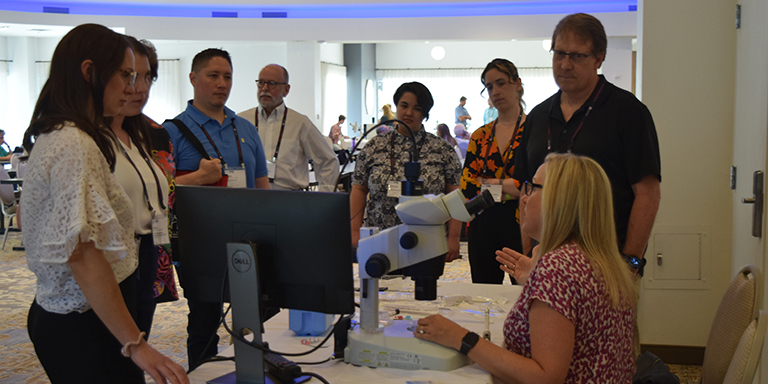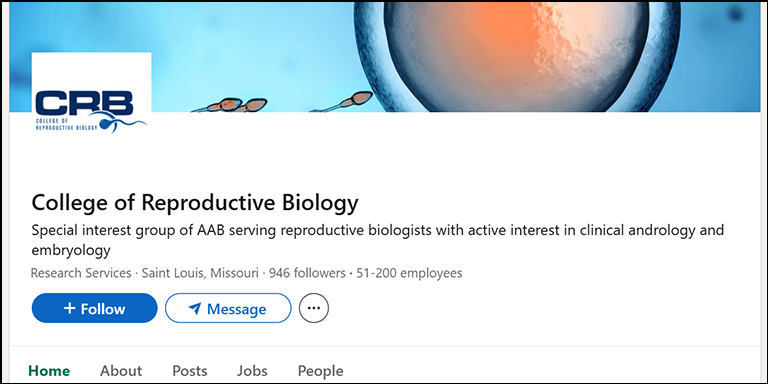
Newsletter
Special Interest Group of the American Association of Bioanalysts (AAB)
Credentialing and Membership Committee – Survey on Impact of COVID-19
Melanie Clemmer, Ph.D., HCLD(ABB)
This year’s Credentialing and Membership Committee consists of Jennifer Baker, M.Sc., TS(ABB); Ali Ahmady, Ph.D., HCLD(ABB); Liesl Nel-Themaat, Ph.D., HCLD(ABB); Thomas O'Leary, Ph.D., M.Sc.; and J. David Wininger, Ph.D., HCLD/CC(ABB). In May 2020, the CRB Credentialing and Membership Committee sent out a survey about the impact of COVID-19 to our colleagues. We wanted to share those results with you even though at this point in the pandemic, the responses might be quite different even if you were asked the same questions.
The primary respondents to our survey were lab supervisors, embryologists and laboratory directors (84% of the 138 responses). Most (81%) respondents were CRB members (with or without subsequent membership in SRBT), likely a reflection of the modes used to disseminate the survey. Corporate, academic/academic hospitals and private/physician owned practices were most represented in this survey (86%).
Initially, the buzz in our field was who was and who wasn’t following the first few COVID-19 guidelines put forth by ASRM. Regardless of whether your clinic was completely (65.2%), partially (30.4%) or not (4.3%) following those guidelines there was much conversation about what was the responsible and appropriate approach to clinics being open or closed. Looking forward, we likely had a greater anticipation for those later ASRM guidelines about how to safely keep our clinics open for staff and patients than pointing fingers at who was and was not open for business in the early days of the pandemic. Positively, most respondents (87%) agreed with their clinics response to those early ASRM guidelines.
COVID-19 was a shock to the world economy, not just to those in our field. While most respondents were initially employed full-time and salaried, that number was reduced by 18% in the early days of the pandemic. Sixty-three (63%) of respondents had changes to their salary, benefits or profit sharing as a result of fiscal changes to clinic closures. It would be of interest to see if those have been restored to date after the initial shock and uncertainty of our altered work environment wore off and clinics reopened.
One positive response to come out of COVID-19 was the creation and availability of webinars for continued education. Perhaps the most successful platform has been the development of the International Infertility Initiative (I3). They allowed the CRB to present two webinars that were developed from content that would have been presented at the annual AAB/CRB symposium that was cancelled. If you were unable to catch them the first time around they can be found online. It seemed like there were more webinars and educational opportunities that one could attend, even for someone furloughed and at home with a sudden increase in their free time. In our survey we asked respondents what topics they thought had been overlooked, despite the increased availability of educational seminars. The answers were varied, but centered in four areas: 1. General laboratory safety and information, 2. Specific laboratory responses to COVID-19, 3. Questions about testing for COVID-19 and 4. Effects of COVID-19 on laboratory staffing. Some of these topics have now been adequately addressed as more information became available but others will be ever evolving as COVID-19 outbreaks influence clinic options for patients and staff. Perhaps some will be addressed in future publications or educational events through CRB.
Employees are navigating new waters with COVID-19 and survey respondents had a variety of valid concerns related to returning to work. They included exposures, job security/income, and possible irresponsible actions by a company attempting to recover lost revenue. My family still navigates the new pattern of hybrid school attendance, rotating between in-person and virtual training every other day; a schedule that doesn’t work well with embryology routines in a small clinic! There are certainly things to be envious of for those that have jobs that can be completed at home, not a possibility for clinical laboratories. However, I think most of us love our jobs and excited to come in to work to provide services.
Survey respondents look to CRB as a resource for many things, especially during COVID-19 responses. When asked what they thought CRB could be doing to assist them with their most significant concerns moving forward they overwhelmingly wanted evidence based information to guide their laboratory practices. In the middle of COVID-19, CRB teamed up with SRBT and SART to generate a joint document on re-opening laboratories; hopefully a start to more collaborative future endeavors. Again, we continue to look for ways to bring evidence-based information to you when it is appropriate.
The Credentialing and Membership Committee have decided that we have much to learn from each other and in the near future we will be posting a series of general questions on various laboratory topics to answer. Be on the lookout for them and stay healthy!



